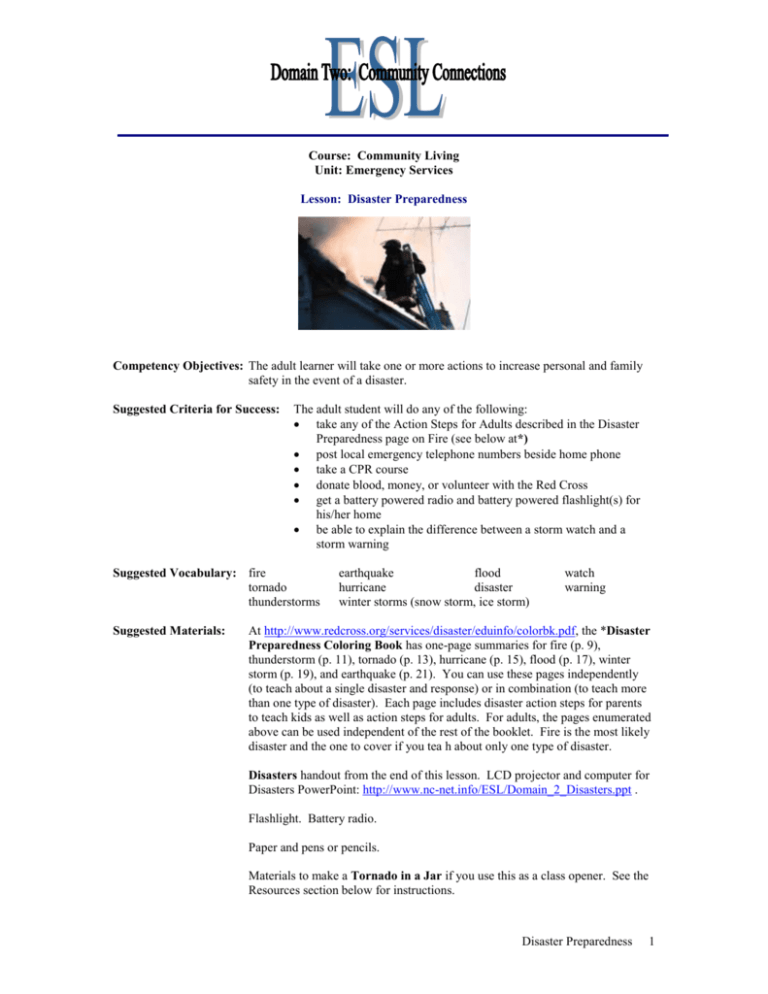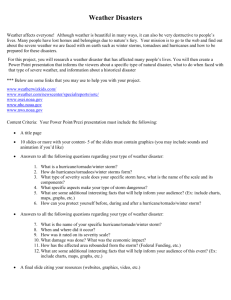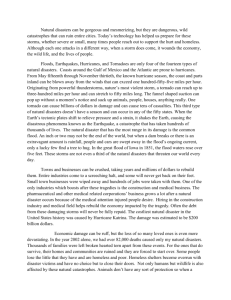Lesson: Disaster Preparedness - NC-NET
advertisement

Course: Community Living Unit: Emergency Services Lesson: Disaster Preparedness Competency Objectives: The adult learner will take one or more actions to increase personal and family safety in the event of a disaster. Suggested Criteria for Success: The adult student will do any of the following: take any of the Action Steps for Adults described in the Disaster Preparedness page on Fire (see below at*) post local emergency telephone numbers beside home phone take a CPR course donate blood, money, or volunteer with the Red Cross get a battery powered radio and battery powered flashlight(s) for his/her home be able to explain the difference between a storm watch and a storm warning Suggested Vocabulary: fire tornado thunderstorms Suggested Materials: earthquake flood hurricane disaster winter storms (snow storm, ice storm) watch warning At http://www.redcross.org/services/disaster/eduinfo/colorbk.pdf, the *Disaster Preparedness Coloring Book has one-page summaries for fire (p. 9), thunderstorm (p. 11), tornado (p. 13), hurricane (p. 15), flood (p. 17), winter storm (p. 19), and earthquake (p. 21). You can use these pages independently (to teach about a single disaster and response) or in combination (to teach more than one type of disaster). Each page includes disaster action steps for parents to teach kids as well as action steps for adults. For adults, the pages enumerated above can be used independent of the rest of the booklet. Fire is the most likely disaster and the one to cover if you tea h about only one type of disaster. Disasters handout from the end of this lesson. LCD projector and computer for Disasters PowerPoint: http://www.nc-net.info/ESL/Domain_2_Disasters.ppt . Flashlight. Battery radio. Paper and pens or pencils. Materials to make a Tornado in a Jar if you use this as a class opener. See the Resources section below for instructions. Disaster Preparedness 1 Suggested Resources: http://www.redcross.org/. At the left of the page, click on Disaster Services (not Our SERVICES). Click on Disaster Safety, then on Thunderstorms. From Disaster Safety, you can also click on Blackouts, Chemical Emergencies, Earthquakes, Fires, Floods, Hurricanes, Tornadoes, and a variety of other disasters. When you click on Tornadoes, continue to scroll down: Under Materials for Children, click on Disaster Preparedness Coloring Book. http://www.crh.noaa.gov/abr/teacher/tornadojar.php Tornado in a Jar. Or try http://www.crh.noaa.gov/abr/teacher/experiments.php and click on Tornado in a Jar. http://members.aol.com/Jakajk/Oneworld.html Click on Page One: ESL Lessons, Games, and Resources and then on Disaster Lessons (under Contents of this Page). http://www.nc.gov Under Quick Links (left side of screen), click on NC Hurricane information for materials addressing Before, During, and After the storm. Links to sites in Spanish are included. http://www.dhhs.state.nc.us/docs/hurricane.htm This Department of Health and Human Services site has information on health and safety during and after a hurricane and flood. Users may choose English or Spanish. Suggested Methods: Discussion, Reading (silently, group, question time), Fill in the Blanks, Demonstration, Journal Work Some Suggested Steps: Introduction. For classes with limited language ability, you may introduce discussion with a demonstration of a tornado in a jar. Distribute the Disasters handout and ask what picture on the handout resembles the activity in the jar. For classes with more language understanding, ask class members if they have lived through very bad weather. When? Where? What happened? If no one has, you (unfortunately) may have experienced flooding or hurricane or fire. Describe your experience, or use any of the following from Hurricane Fran. It was midnight. The wind was howling. The rain came down hard. The power went out. All lights went out. Tree limbs were falling. You could hear them crack. A tree fell across my front entrance. I got out of bed, dressed, and put on sturdy shoes. I put on my watch. All electric clocks were stopped. My purse had a shoulder strap, so I put it across my body and put a flashlight and a small portable radio in it. I wouldn’t turn on the flashlight: I might need it later. Car headlights crept by outside. There was a terrible crash and one set of headlights disappeared into the creek beside my house. I moved back from the windows. The telephone line was dead: I couldn’t call for help for the wreck victim. The storm raged. Finally it got quiet outside. In a few hours, morning light began to dawn. There were many trees down around my house. A truck was nose down in the creek, but no one was in it. I later learned that the driver got out and went to a neighbor’s house—one without a tree across the door. For four days our neighborhood was without water: the truck cracked the waterline when it went into the creek and the city had to shut off the water. We were without electricity. The weather was hot. We cleaned up tree limbs in the yard, but we couldn’t shower afterward. One family drove to their parents’ home in another town to bring water back for everyone. Credit cards didn’t work because the electricity was out. We were low on cash. Without power, the banks were closed. There was no refrigeration for food and no electricity to cook. One neighbor with an outdoor grill cooked anything neighbors brought there. We went to bed when it got dark and got Disaster Preparedness 2 up with the sun. Workers from across the state came to help restore power, and in a few days the city repaired the waterline. Cleanup and repairs went on for many months. Vocabulary. See if students can name any of the disasters pictured on their Disaster page. Uses the Disasters power point to help students label each drawing. Be sure everyone can pronounce the vocabulary words for this lesson. Discussion. What things do you take for granted that are lost in most disasters? Let students give English words or descriptions or drawings to the best of their abilities. Cover things like running water, electricity/gas. Will you have drinking water? Can you shower? Cook? Keep food in the refrigerator? Flush the toilet? Run heat or air conditioning? Use a credit card? Wash clothes? Turn on the lights? Watch television? Listen to the radio? Use the last questions about lights-TV-radio as a springboard into discussion about what you could use to see in the dark and how you could find out about the disaster situation while you are without power. If you have a night class, stand beside the light switch while asking your question and turn off all the lights. Turn on a flashlight. Are candles safe or unsafe? Is a kerosene heater safe? How can you follow weather alerts when the power is out? How many in the class have a flashlight and a battery powered radio at home? Do the batteries still work? Do they know at this moment where to locate their flashlight and radio? Watch or Warning? Ask your students: When the weather report says the county is under a storm watch, what does that mean? Is there a difference in a storm watch and a storm warning? (In a watch, conditions are right for the weather to occur. A warning means the weather is imminent and one should take appropriate action.) How can they remember the difference? Let students suggest memory associations that work for them. Reading. Let students guess the most frequently experienced type of disaster. Those who say fire are correct. Distribute and read together the page on Fire from the Disaster Preparedness Coloring Book. Go over words and take questions from students about meaning as needed. Give the attached handout of sentences to complete by circling the correct answer. Discussion. Ask students what they can do to help in a disaster when they are not victims. List their answers. Work as a group to edit the work. Let the students copy the list in their Journals. Journal Work. Draw a floor plan of your house or apartment. Show two ways to escape from every room. Beneath your drawing write the outside location where you will meet others in case of a fire (e.g., at a certain neighbor’s front walk). When you make this assignment, demonstrate what you want students to do by drawing your own house or apartment (or use a floor plan from a newspaper or magazine). Indicate two ways that you could escape from every room. An alternate assignment could include more writing: write about a time you were in a disaster (hurricane, fire, flood, earthquake, tornado, ice/snow storm) write about the things you can do to help people far away who have a disaster Disaster Preparedness 3 COMPLETE THE SENTENCES BY CIRCLING ALL CORRECT ANSWERS SENTENCE ANSWER Never play with ______________. fire matches lighters toys Never use _____________ in a building on fire. an elevator Never yell __________ unless it is true. hooray Never run if your ___________ are on fire. clothes cigarettes If you are in a fire, never __________ a door if it is hot. lock open Smoke goes _______, so there is more air to breathe if you _______________. up down sideways crawl on the floor jump on the bed run across the room quickly At home, you should have meeting place where everyone will go in case of fire. Why? Never go back into a building that is ________________. You can tell quickly if all family members are safe. Everyone will know what to do. burning closed open Frayed ______________________, loose plugs, and exposed wires are dangerous. extension cords Change the batteries in smoke detectors at least once a _____________. year a fire extinguisher fire week yippee help slam blue jeans month Disaster Preparedness 4 Disasters Put the word with the picture. Snowstorm Thunderstorm Earthquake Fire Tornado Flood Hurricane Disaster Preparedness 5







